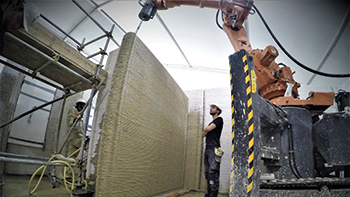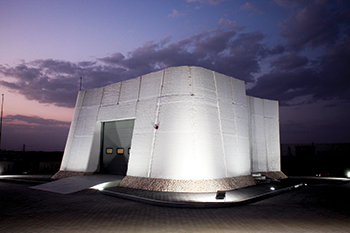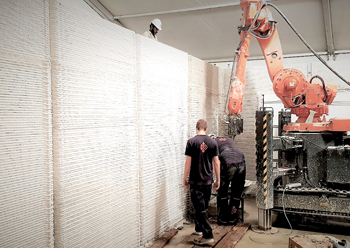CyBe helps shape first 3D printed homes
01 May 2019
3D printed homes are set to become mass production housing solutions, thanks to a world-first project that was conducted jointly by CyBe and leading regional contractor Consolidated Contractors Company (CCC) to test the technology in mainstream construction, says the Netherlands-based award-winning tech company.
The 3D Studio 2030 Project is an 80-sq-m single bedroom house that comprises 48 elements, 27 walls and 21 parapets. It was printed in less than a week on site in the Saudi desert.
The project was an experiment undertaken to offer mass production solutions to Saudi Arabia’s burgeoning housing problem. CyBe executed the project with CCC for the kingdom’s Housing Ministry with its scope of works including everything from engineering, construction and certification to education.
 |
|
The printer’s ABB robotic arm is placed on a moveable crawler. |
Both companies were commissioned by the National Housing Company to create the prototype as part of a vision to transform the housing industry worldwide with innovative technologies – meeting the ever-growing, critical housing demands on local and global scales.
In an interview with Gulf Construction, Berry Hendriks, the CEO and founder of CyBe, says the aim of the experiment was to compete with the advances being made worldwide in future construction technologies, benefit from the latest technologies, and be a pioneer in promoting the adoption of innovative construction techniques in the construction sector. This is in line with the objectives of Saudi Arabia’s Vision 2030 and the National Transition 2020 Programme.
He says: “The collaborative project is the first of many steps in realising 3D printing as a mainstream construction method and certifying new approaches, such as load-bearing walls and complete mechanical, electrical and plumbing (MEP) integration. At the same time, printing approaches explored in the pilot project were thoroughly investigated for implementation in future phases.”
Building components such as windows, doors and electricity sockets were placed while printing. Furthermore, local operators were educated on how to safely operate the 3D concrete printer. The local print operators will soon start printing the next phase of this huge project to contribute to Saudi Arabia’s housing target, says Hendriks.
This 3D Studio 2030 will be the first of many houses since the Saudi government has set the ambitious Vision 2030 to realise 1.5 million houses using innovative technologies like 3D concrete printing and fast-brick robotics, he adds.
Hendriks says the project is not simply a ‘proof of concept’ regarding 3D printing technology. Rather, it examines the realistic adoption of 3D printing technology in mainstream construction. “The prototype took 3D printing from an ‘abstract future vision’ through to real-life implementation as a mainstream solution,” he points out.
Hendriks says the initiative also demonstrated the capabilities of 3D printing technology, and its potential benefits to the housing market. The project addressed engineering challenges associated with the 3D printing approach and its integration into the strict requirements of the construction industry.
“The 3D Studio 2030 Project is the first realistic collaboration between a global construction company with seven decades of experience, and a technology provider, blending the ‘old’ with the ‘new’ and achieving great success,” says Hendriks.
 |
|
The R&Drone Laboratory project in Dubai. |
For this project, CyBe brought in its own printer – the CyBe RC 3Dp – from the Netherlands. This model is a mobile printer suitable for users who want to print on multiple locations, and is described as being ideal for construction companies.
The printer’s ABB robotic arm is placed on a moveable crawler, and the rubber tracks underneath the crawler make manoeuvring easy, while the extendable hydraulic feet give the printer its stability during printing and increases the total printable height.
The mix pump system pumps the CyBe Mortar through a concrete hose to the robotic arm, which prints the mortar at the programmed location. The robot is controlled by a control unit including CyBe control and slice software.
Other raw materials used for the project include additive (retarder) and water.
Hendriks sees 3D printed homes as mass production solutions. “The current urbanisation boom leads to the growth of slums and, therefore there is a strong need for development strategies to improve these conditions. Cybe 3D printing of affordable housing concepts seeks to redefine construction, spatial interventions and make a change,” he says.
3D printing offers the benefits of being cheaper, faster, more sustainable, and requiring less raw material and producing less waste. It also needs fewer construction personnel, and less heavy labour due to the automated processes thus improving the quality and reliability of building structure. Other advantages include the reduced production time, since the printer doesn’t need a break and the material dries quickly. Furthermore, the process offers the freedom of design for round shapes, edges etc.
Hendriks says design concepts are aligned with local regulations and can be used globally. This, he says, is possible due to the modular character of the design, similar to the nature of printing technology. The concepts are then shared with global partners. “In construction, we work together!” he remarks.
Apart from homes, 3D printing can be used to build bridges, manufacture manholes, street furniture, and artificial reefs.
CyBe operates from its headquarters in The Netherlands and currently does not have an office in Saudi Arabia. It operates globally with different partners in many countries. In the Gulf, it has executed projects in the UAE, including in Dubai and Sharjah.
In Dubai, it printed the R&Drone Laboratory project for the Dubai Electricity and Water Authority (Dewa) in Q2 2017. Appointed as a subcontractor for the engineering and construction of 3D printing works, CyBe executed the project in 46 hours over three weeks on site in the Dubai desert. This laboratory – believed to be the world’s first 3D printed laboratory – will conduct research on drones and 3D printing technologies and is based at the solar park as a part of Dewa’s Research and Development (R&D) Centre.
CyBe also offers customers the option to buy 3D concrete printers, similar to the model it used for the 3D Studio 2030 Project. Hendriks says the cost for a mobile printer starts at €180,000 ($203,648) and the fixed model starts from €130,000 – ex-works. The company also sells refurbished robots for 3D concrete printing, in addition to fast-setting sustainable material, as well as software to simplify the complex building processes.
Hendriks says CyBe is redefining traditional approaches in construction through far-reaching automation and digitalisation.
“This is enhanced through enabling 3D concrete printing and parametric design tools which are made accessible for all clients. Part of our mission also includes guiding the industry through education, certification and business development,” he concludes.
- On the growth path
- Red Sea splendour
- A capital entertainment hub
- Greening the desert
- New 133-key Hilton opens in Jubail
- Mega projects benefit from K&A’s expertise
- Losberger De Boer eyes booming cinema market
- Masah builds new Al Khobar landmark
- CyBe helps shape first 3D printed homes
- Ariston aims to cater to Saudi clients
- Saudi projects at a glance



